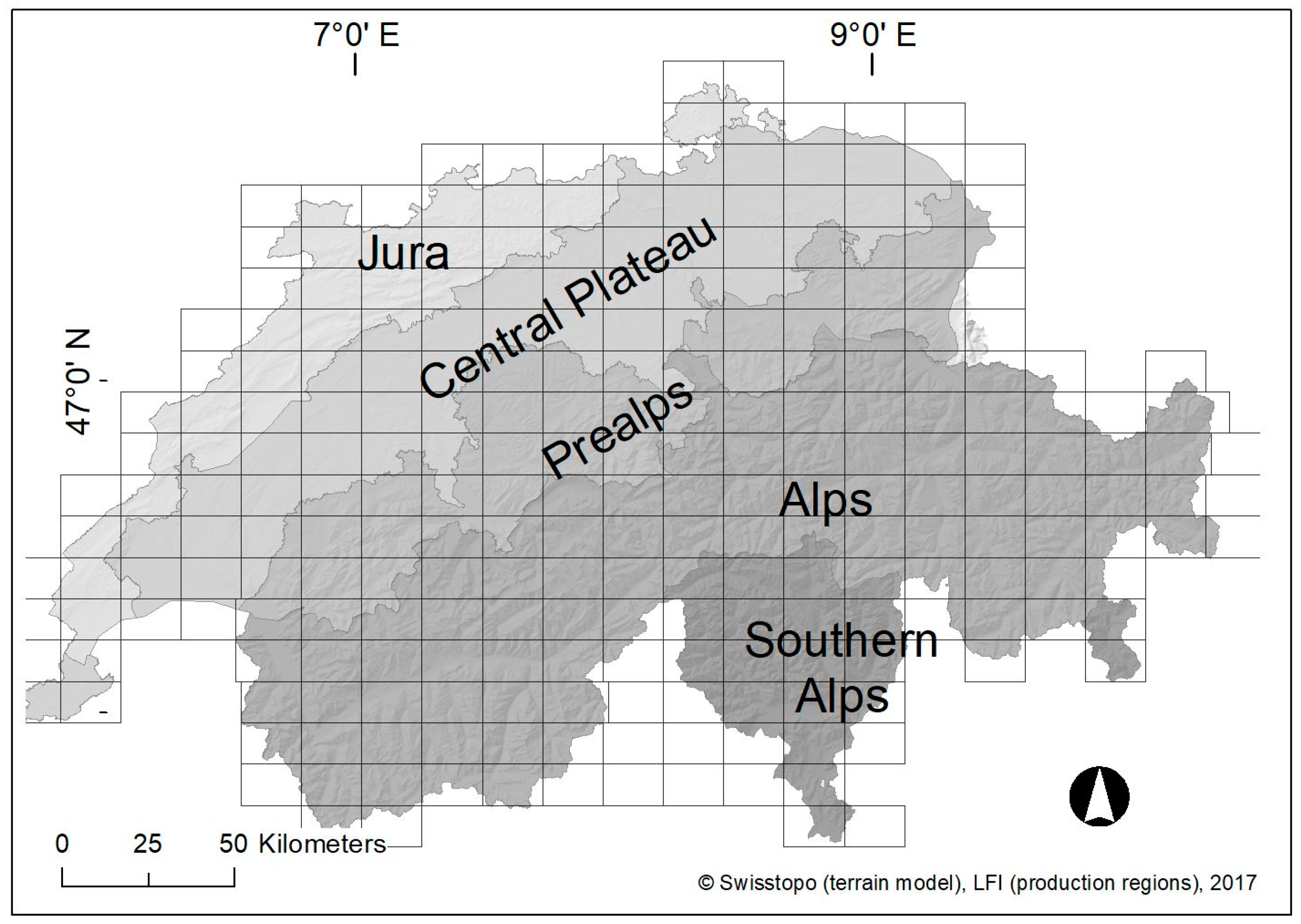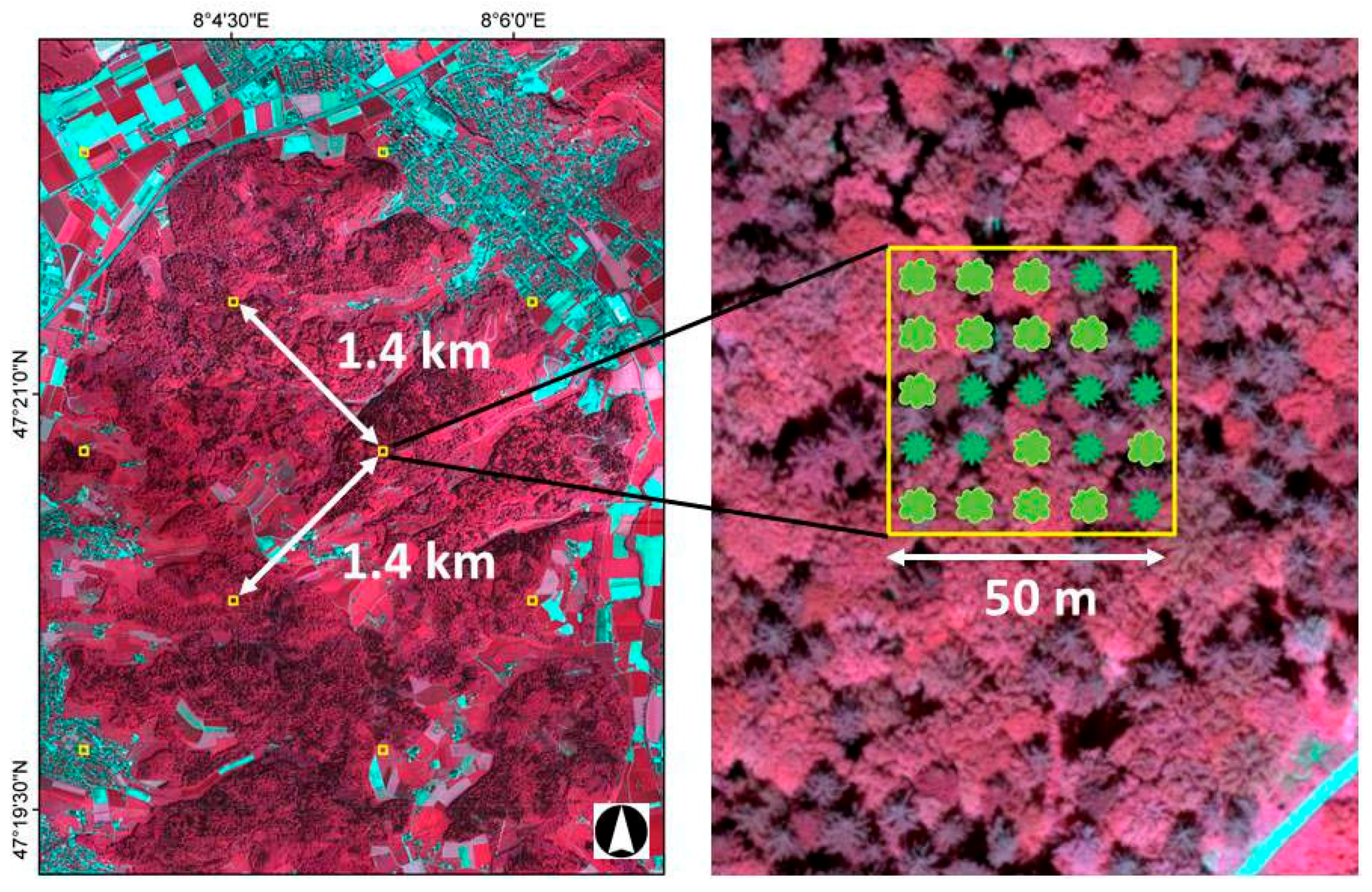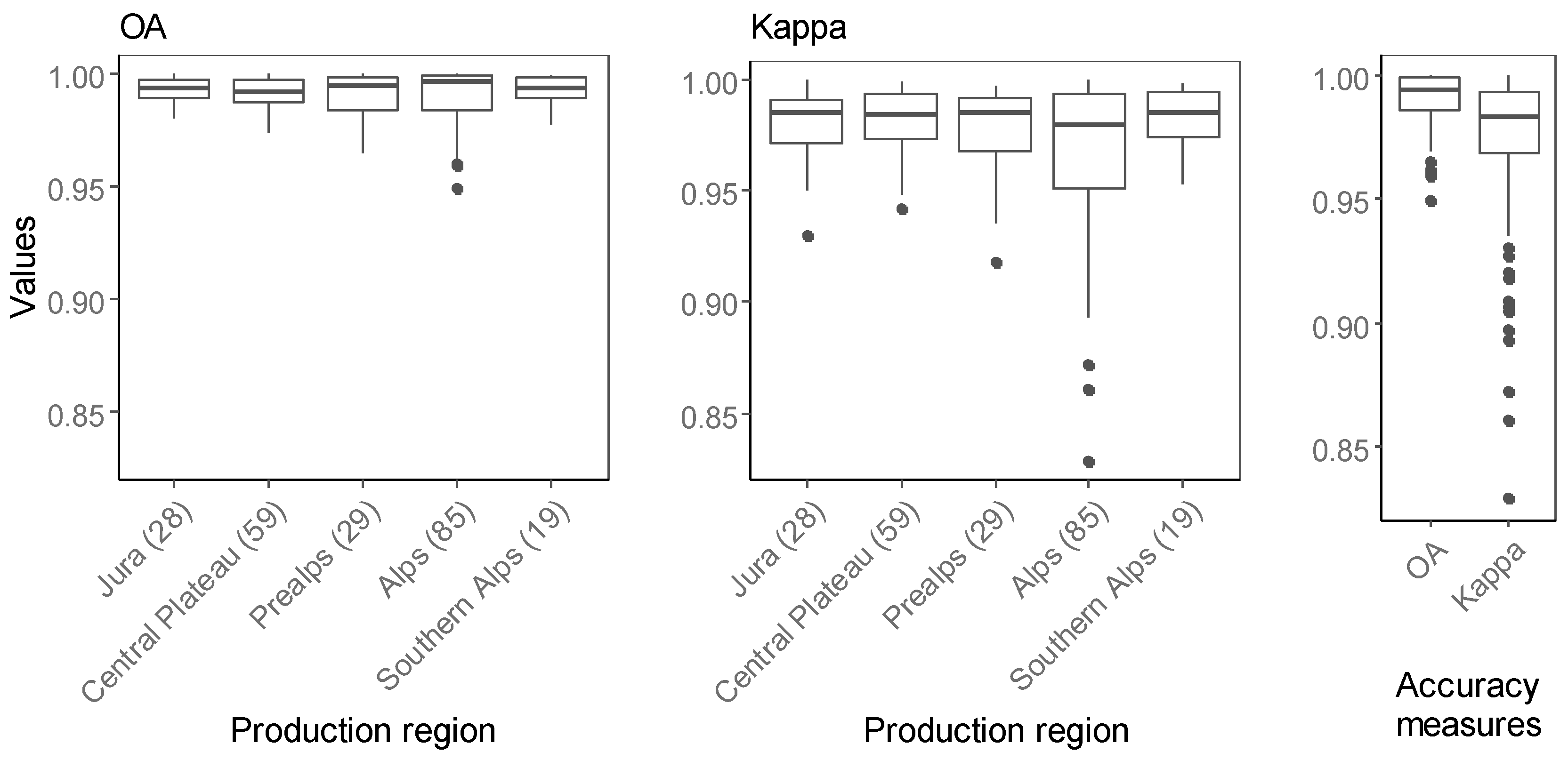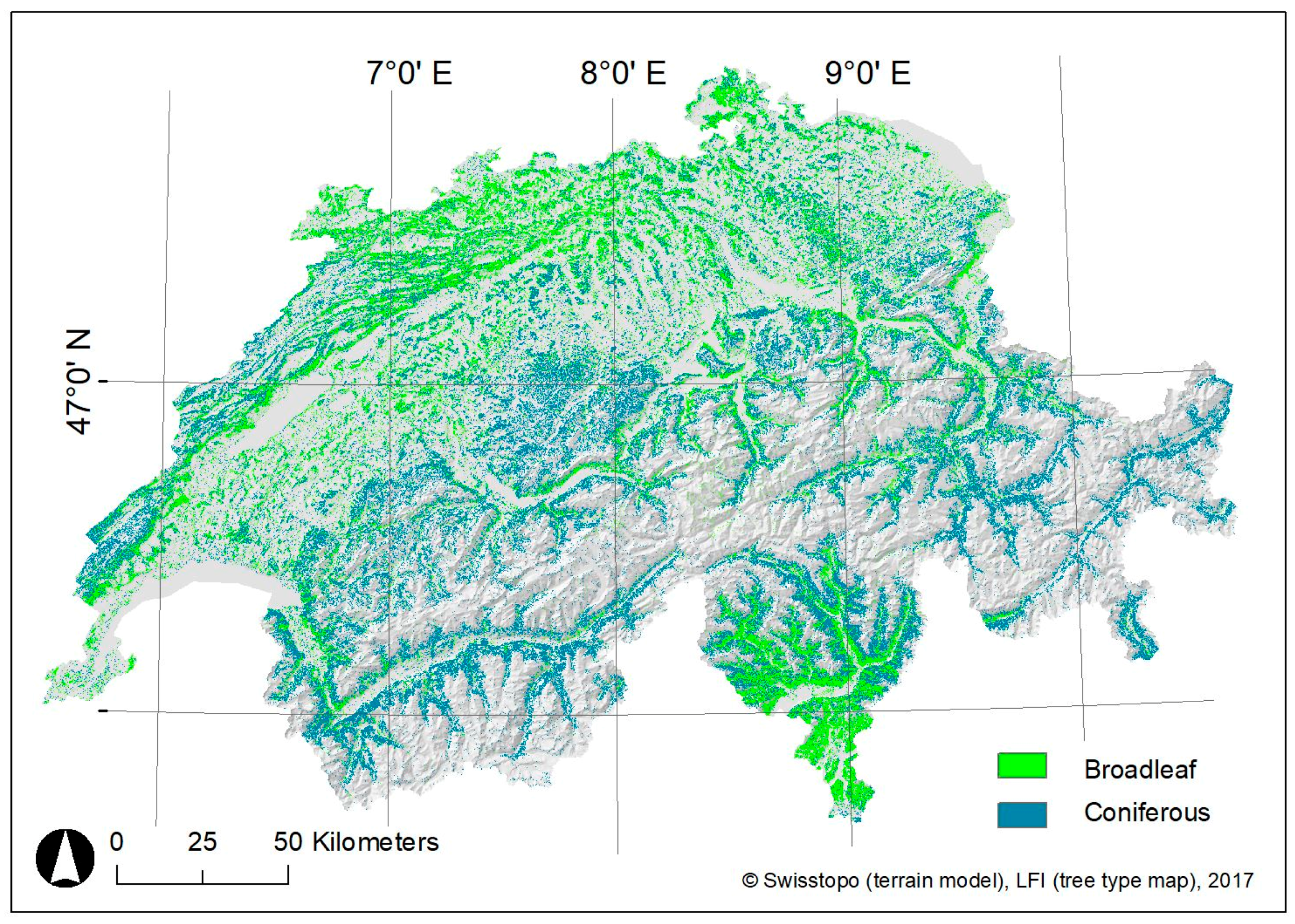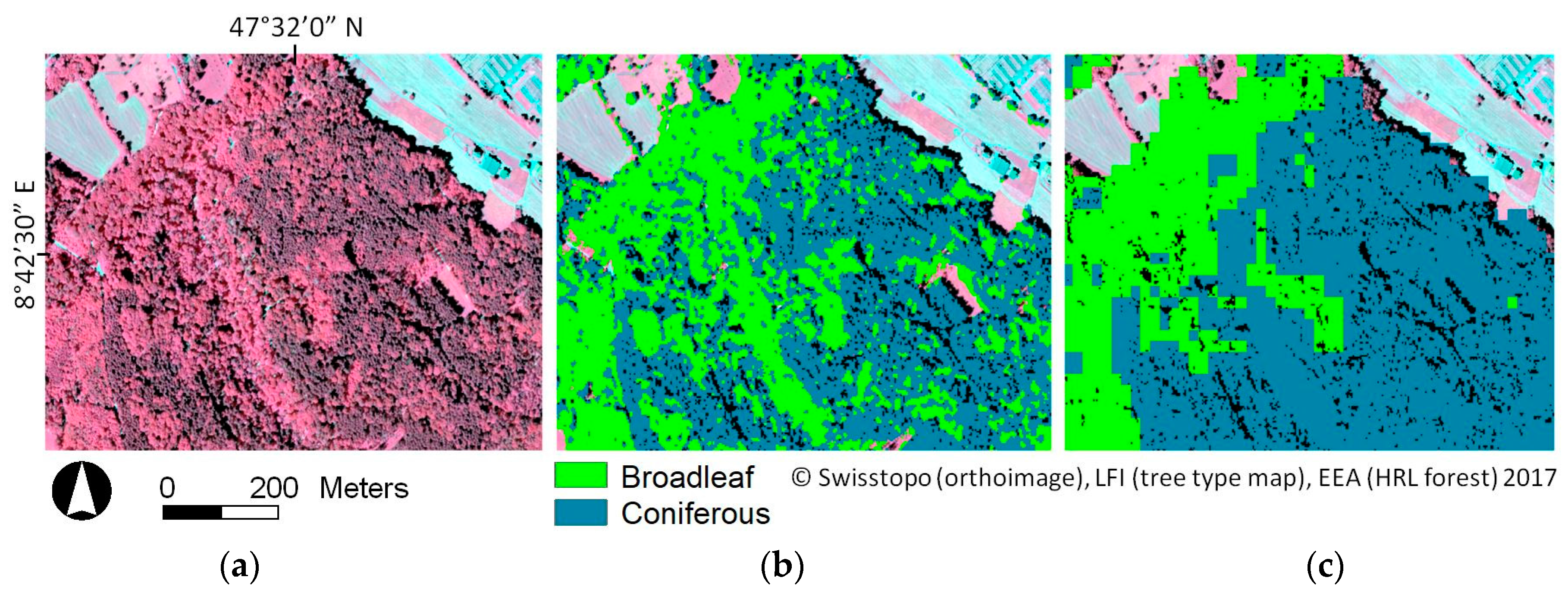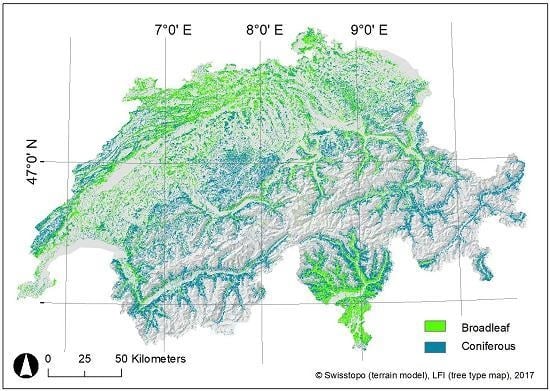1. Introduction
Precise and regularly updated information on the state, change and distribution of tree types (broadleaved and coniferous tree) is essential for forest related studies, e.g., growing stock estimation [
1], biodiversity assessment and monitoring [
2], hazard and disease management [
3], and sustainable forest management [
4]. Forest inventories provide a precise statistical estimation of forest composition for large areas, but spatially explicit information beyond inventory domains is missing [
5]. Thus, maps of broadleaved and coniferous trees are an important source of information for assessing woodland resources and an additional valuable output of National Forest Inventories (NFI) [
6].
Although the development of remote sensing data sets and methods has opened new perspectives and reached an operational level in the last years, countrywide mapping approaches and sound verification on the tree type level remain rare. In fact, the focus has been placed entirely on either new sensor developments that provide higher spatial, spectral, radiometric and temporal resolution or new image processing and classification approaches [
7]. Thus, information on the state and distribution of tree types on a national level has usually been obtained by field inventories [
6].
While studies using remote sensing data to map forest composition and tree species reach back several decades, operational countrywide applications have remained uncommon because of economic constraints, as well as low quality imagery, unrepeated flight campaigns and an NFI focus on statistical output and sample-based data collections. Tree species classification approaches based on remote sensing data using the entire line-up of active and passive remote sensing sensors and methods, mostly designed for case studies, range from simple distinction between broadleaved and coniferous trees [
8,
9,
10,
11] to identifying main tree species [
12,
13,
14,
15]. A comprehensive overview of tree species classification studies is given in the review paper of Fassnacht et al. [
7]. In contrast, few studies have covered large geographical extents, e.g., Schumacher and Nord-Larson [
16] presented a countrywide wall-to-wall forest attribute map of Denmark, and such studies have been carried out as a side-aspect of other land cover classifications, e.g., the CORINE 2006 land cover (CLC 2006) [
17].
Existing maps that principally enable a distinction between broadleaved and coniferous trees are categorical-type maps based on remote sensing techniques and data sets. They have been performed in the framework of global mapping or resource assessment programs and thus vary in legends, spatial resolution (mostly 1 km), temporal coverage, etc. Mentionable are the Global Land Cover (GLC 2000) mapping approach [
18], the GlobCover land cover map Version 2 [
19], and the MODIS land cover type (MCD12Q1) [
20]. Review and uncertainty assessments of these data sets are given in [
21]. For Europe, the High Resolution Layers (HRL forest 2012) 20 m forest type map [
22] and the European 25 m Forest cover and type map from the Joint Research Center (JRC) [
23] are the currently available tree type maps. Finally, Brus et al. [
24] presented a 1-km resolution European mapping approach showing the distribution of 20 tree species based on NFI plot data. However, despite the undoubted value of these existing large-scale tree type maps for many applications, unavoidable restrictions due to the coarse spatial resolution and thus the insufficiently detailed representation of tree types (on coniferous and broadleaved level) occur for many forest management demands, especially those at the stand level [
7]. Thus, mixed stands in particular are not detected because small-scale information is combined into one pixel. This is an important shortcoming in Switzerland, where mixed stands account for more than 30% of forested area [
25].
Although various methods have been developed and used for mapping tree types of forest ecosystems using different remote sensing data, there have been few studies that indicate which method leads to the most accurate models. Remote sensing-based tree species classification has evolved with methodological developments in the domain of statistical learning [
7]. Since the mid-1990s, non-parametric decision tree based classifiers, e.g., Random Forest (RF) and Artificial Neural Networks (ANN), have emerged as an alternative to the other classifiers, i.e., unsupervised or parametric methods. Non-parametric methods have the advantage that they do not make assumptions about data distribution, as a normal distribution is not always given [
26]. According to Breiman [
27] and Hastie et al. [
28], RF is one of the most accurate machine learning algorithms. RF is relatively insensitive to the number of input data and the multicollinearity of the data, and it has a smaller prediction variance and therefore usually a better general performance. It runs efficiently on large data sets and may therefore be suitable for countrywide approaches. Moreover, Belgiu and Drăguţ [
29] showed in their review paper that the RF classifier outperforms other decision tree classifiers regarding accuracy, training time and stability of the classifier.
New perspectives for countrywide mapping approaches are emerging through digital aerial imagery, which are likely—in contrast to ALS—to be updated more regularly by national mapping agencies [
6]. Thus, the possibility of extending the statistical, plot based NFI information to a continuous, landscape level representation has become more feasible. As a part of the Swiss NFI program, wall-to-wall stereo-aerial imagery, provided by the Federal Office of Topography, Swisstopo, on an ongoing cycle with repeated coverage every 6 years, is analyzed [
30].
The main objective of the present study was to generate a new high-resolution wall-to-wall tree type map, that consists of the two classes broadleaved and coniferous, for Switzerland. Despite the distinction of only two broad tree type classes, the proposed method is advantageous to other mapping approaches to construct countrywide classification models due to two facts: first, because it uses repeated acquisitions of the same digital aerial imagery and is not the product of different remote sensing data sources, and second, a reliable reference data set exists, which is independent from the training data.
Furthermore, the proposed method was optimized in order to be suitable for European temperate mixed forests within a complex topography. In this paper, we demonstrate a novel approach to deriving a countrywide tree type map with a spatial resolution of 3 m that (i) uses digital aerial imagery and a RF classifier; (ii) is highly automated and reproducible, minimizes computation time, and produces high model and prediction accuracies; and (iii) uses digitized polygons of broadleaved and coniferous trees for model adjustment; and (iv) independent NFI data (aerial photo interpretation) for validation. The tree type map complements the existing spatially explicit countrywide data sets, i.e., the Vegetation Height Model (VHM) [
30] and the forest cover map [
3] of the Swiss NFI. It is superior to the existing tree type maps regarding level of detail, accuracy and being up-to-date. It also supports forest management demands by providing detailed information on forest composition at the stand level.
4. Discussion
4.1. General Aspects of the Tree Type Mapping Approach
From a methodological point of view, the presented approach is appropriate for wall-to-wall mapping of entire countries. It is flexible regarding the kind of input data sets that are routinely acquired during the vegetation season over a time span of a few years, and it can process such data sets in a reasonable computation time. The generation of training samples for the tree type map was a time intensive and—to a certain degree—subjective task in the entire methodological workflow. At first glance, the large number of over 185,000 digitized training polygons might seem to be overdrawn, but it was required for obtaining representative samples for imagery from different acquisition times and years and was necessary because NFI data were only used as an independent data set for validation. Due to the sensitivity of RF classification to the sampling design and imbalanced training samples [
51,
52], the training samples for the tree type map had to be balanced and representative of the two classes, i.e., area-proportional, and large enough to accommodate the large number of data dimensions. In fact, reducing the number of samples to a certain degree would only slightly lower the model accuracies [
7] but would have a greater (negative) impact on the prediction of the tree types. To the best of our knowledge, no other countrywide approaches exist that have used additional independent data to validate the predictions. For example, NFI plot data were used as training and validation data to predict forest resources in combination with ALS data [
16] and with satellite imagery [
53]. Although the collection of sufficient training data was a time consuming part of the process, the tree type mapping approach as a whole remains highly automated due to two facts.
First, pretesting was applied to five representative areas in order to determine the exploratory variables that contributed most (thereby reducing the large amount of data) and to assess the most appropriate classification algorithm. Compared with LRM and SVM, the RF classifier clearly performed best regarding computation time but did not result in significantly higher model accuracies. This finding is in accordance with results from other related studies [
7,
15,
26].
Second, computing tree type was facilitated by splitting the entire area into 220 subsets. Remarkably, the aggregation of the predictions of the subsets to the connected tree type map produced no serious border effects or abrupt changes of the tree types within the forest stands, indicating that the modelling approach was robust. It seems that these effects usually increased when neighboring images were acquired on different dates (see
Section 4.4).
The computation of explanatory variables was based on previous case studies [
12,
33] that dealt with tree species classification using the same countrywide image and ALS data. In accordance with these studies, the simple usage of the four original image bands, the band ratios, and the index MSAVI enabled us to classify tree types with high accuracy. The topographic variables aspect and elevation were further used to reduce the effects of relief shadows and large elevation differences in the terrain (see
Section 4.4). Furthermore, first feedback from users of the tree type map, i.e., foresters, environmental agencies and governmental authorities, are positive and reveal that the spatial resolution and level of detail are sufficient. Thus, we believe that the tree type map approach provides an optimal balance between a sufficient level of detail and reasonable computation time. In their review paper, [
7] reported that a successful species classification is not solely based on a high spatial resolution but depends on other factors, e.g., spectral resolution, the availability of representative reference data and the mission behind it, i.e., the end user.
4.2. Tree Type Map Compared with NFI Data
Although the classification models yielded a high level of precision across the entire data set, predicted values were generally positively biased compared with NFI data for coniferous and negatively biased for broadleaves trees. However, NFI interpretation is an independent data set for comparisons rather than the truth, and therefore the absolute deviations must be carefully interpreted. Moreover, due to the fact that estimation accuracies for broadleaved and coniferous fractions by terrestrial field surveys are in the range of 10% [
54], the obtained differences between predicted and observed broadleaved fractions of less than 10% can be interpreted as reasonable (50.6% of IAs).
Table 5 reveals that underestimation of the broadleaved fraction mainly occurs in mixed forests in all parts of the country, with a higher concentration in the Central Plateau, the Jura and the Prealps. It increases with decreasing elevation and is therefore more distinctive for broadleaved stands—especially in areas with west and north terrain expositions. Broadleaved trees are dominant in regions below approx. 1000 m a.s.l., and coniferous trees are dominant above this elevation. Applying multiple linear regression revealed that production region, terrain exposition, elevation a.s.l., percentage of coniferous trees, presence of other land cover classes and time lag of the imagery used for the NFI data and the tree type map have a significant influence on the agreement between the predicted (tree type map) and observed (NFI image interpretation) broadleaved fraction in the IAs (
Table 6). The reasons for the deviations are manifold and can be separated by these parameters.
First, the parameter production region had a significant effect on the agreement of broadleaved fractions between the tree type map and the NFI data. In the Prealps and Alps, the agreements differed from the Jura at the 0.001 significance level, whereas the Central Plateau and Southern Alps differed from the Jura at the 0.05 significance level.
Second, terrain exposition was a key factor contributing to the overestimation of conifers on northern slopes. This effect increased in alpine regions but also occurred in the hilly regions of the Central Plateau. Moreover,
Table 6 reveals that the agreement between the two data sets was significantly higher for slopes with east, south and west expositions. Terrain exposition clearly affected the spectral properties of the broadleaved trees in particular (see
Section 4.4). The sun-sensor geometries were responsible for shadows in the northern and particularly western expositions and affected the tree type mapping.
Third, elevation had a significant influence on the agreement between the two data sets. The deviations decreased significantly with increasing elevation, which meant a decrease in the fraction of broadleaved trees.
Fourth, a decrease in the fraction of coniferous trees had a significant impact on the agreement between the two data sets. The highest deviations occurred for mixed stands with a proportion of conifers between 11% and 50%, and there was a slight decrease in deviation for pure broadleaved stands. Thus, to a certain degree, the fewer coniferous trees present, the higher the deviations. This is in accordance with the parameter elevation. Moreover, visual inspection revealed that this effect decreased for young or very closed broadleaved stands because shorter trees and denser crowns have smaller cast shadows and shadows within crowns.
Fifth, analogous to the forest mask [
3], it was expected that forest edge might have an impact on the agreement between the two data sets. Although
Table 5 indicates that deviations between the two data sets were greater at the forest edge than within the forest,
Table 6 shows that the location of the IAs had no significant influence. This was also caused by removing the IAs with fewer than nine points interpreted as trees (which is often the case for IAs at the forest edge) during the stepwise fitting of multiple linear regression. Moreover, visual inspection of the tree type map revealed that the shape of extracted tree patches, e.g., linear tree cover elements, groups of trees and single trees in orchards or urban areas, affected the classification more than proximity to the forest edge. As trees located at the forest edge were often misclassified as conifers, this is a particular weakness of the countrywide data set.
Sixth,
Table 6 reveals that the presence of other land cover classes (e.g., shrubs, grass, bare soil) had a significant influence on the agreement between the two data sets. Whereas the photogrammetric experts most likely interpret these classes correctly using the stereo-images, even in the shadowed parts, they were neglected by the classification approach and were classified as coniferous trees.
Seventh, a time lag between the imagery used for the stereo-interpretation and the imagery used for the tree type map equal or greater than 6 years had a significant influence on the agreement between the two data sets. The greater the time lag between the two images, the more likely the proportion of broadleaved and coniferous trees within the IAs has changed (forest management, storm event).
Finally, slight differences between the two data sets might have resulted from the tree cover mask, which was based on the countrywide vegetation height model. According to Ginzler and Hobi [
30], VHM is less accurate and more error-prone in areas with shadows for which image-matching is particularly challenging.
4.3. Map Quality Compared to Pre-Existing Maps
In principle, a comparison of the tree type map with pre-existing maps is informative and helpful for interpreting differences between the data sets. However, the existing global data sets are too coarse, with a spatial resolution of 0.5–1 km, and outdated. Furthermore, comparisons with the only and latest official available tree type map of Switzerland (WMG25) provided by the Federal Statistical Office [
55], and also with the European 25 m resolution forest cover and type map from the Joint Research Center (JRC) [
23], were regarded as inappropriate because substantial changes in the forest composition likely occurred since these maps were produced more than 10 years in advance [
25]. Thus, the most appropriate remaining data set is the High Resolution Layers (HRL forest 2012) 20-m resolution forest type map [
22], which is the most recent available and detailed map of Switzerland.
Similar to the tree type map, HRL forest 2012 was compared with the IAs and the deviations in broadleaved fraction was assessed. The validation was performed for 3210 IAs (163 fewer IAs than for the tree type map due to the different extent of the data sets) that had at least nine points interpreted as trees. For details on the numbers see
Table A1 (
Appendix). The comparison revealed that this map deviated more from the IAs than the tree type map (e.g.,
RMSE 34.8% versus 26.5%), but the overestimation and underestimation of broadleaved fractions was more even over the entire country (median 0% versus −3.2%). However, the large difference in spatial resolution between the tree type map (3 m) and the HRL forest 2012 forest type map relativizes the absolute numbers obtained by the comparisons. Although this might suggest a roughly comparable spatial distribution of the tree types from the tree type map and the HRL forest 2012 forest type map,
Figure 8 clearly shows that this was not the case. The differences are more likely due to misclassifications of the Landsat imagery and the coarser spatial resolution than the time gap of a few years between the two data sets. Change in forest composition is a relatively slow process over many years, with the exception of clear cutting or storm events.
Furthermore,
Table A1 (conifers in %) reveals that the purer a stand is—broadleaved or coniferous—the smaller the differences between the NFI data and the HRL forest 2012 layer. In contrast to the tree type map, deviations increased in regions between 600 m and 1400 m a.s.l., which are clearly dominated by mixed stands. This is a particular drawback of the HRL forest 2012 forest type map because Switzerland is dominated by mixed stands over large areas (Central Plateau, Jura, Prealps). Thus, the HRL forest 2012 forest type map might be more appropriate in boreal forests or in forests with pure stands. The HRL forest 2012 forest type map also seems to be less sensitive than the tree type map to the parameter location and presence of other land cover classes. Slightly higher deviations between NFI data and the HRL forest 2012 forest type map (compared with the tree type map) were obtained for north-oriented areas, most likely due to image-related constraints, i.e., illumination and acquisition date and time, similar to those of the tree type map.
4.4. Constraints of the Tree Type Mapping Approach
Sources of error in the tree type map are manifold and are related more to the input image data and less to the proposed classification approach. As expected, date and time of data acquisition influenced phenology and illumination of the images, which led to high spectral variability, and thus had a large impact on the resulting tree type map, in particular regarding broadleaved trees. The few image strips acquired in early June were not optimal for mountainous regions. Whereas trees in the valleys already had unfolded leaves, foliage was still missing in higher areas. Thus, for classifying tree types in the Central European Alps, image acquisition should be limited to from the end of June to the end of August and preferably completed around noon to provide a large zenith angle of the sun. Besides the phenological aspects, the negative impact of illumination effects, such as cast shadows or shadows within crowns, could be minimized in this way. However, the present study had to cope with two restrictions: first, the imagery was acquired on an operational basis by the national mapping agency in an ongoing cycle and therefore not on request with individual user specifications. Second, topographic and radiometric corrections, often suggested in the literature [
56], caused severe artifacts, i.e., blurred areas, over large areas and also in areas, i.e., flat terrain, that were less affected by the topography. Assuming that topography in particular might affect illumination and spectral separability of broadleaved and coniferous trees, two RF classifications for a subset of approx. 200 km
2 were performed, one based on the original RGBI imagery and the other based on the ATCOR3 [
57] corrected imagery. The tests revealed that these artifacts affected the classification and resulted in lower overall accuracies (OA 0.982 for the original imagery, 0.941 for the corrected imagery (based on 840 digitized polygons, 10-fold cross-validated)).
In contrast, using the two topographic variables elevation and aspect for the tree type classification partly reduced the spectral variability, in particular that of broadleaved trees. Large differences in elevation that occurred for image strips covering areas between approx. 400 m and 2000 m a.s.l. were satisfactorily compensated with the topographic variable elevation (see
Figure 9). In contrast, by implementing the variable terrain exposition, errors of commission of coniferous tree types in north-oriented slopes were only marginally reduced.
Figure 9 shows that additional rigorous masking of shadows was necessary. When focusing on large geographic extents, it would be more beneficial to reduce spectral variability by integrating topo-climatic variables into the classification approach [
41].
Both the classification algorithm and unit (the 3-m regular raster) may also affect the tree type mapping approach. The stability of the RF classifier was an important criterion for its integration into operational settings and thus suitability for wall-to-wall applications [
29]. Vetrivel et al. [
58] reported that the overall classification accuracy of the RF classifier decreases when the algorithm is trained on different study areas. Juel et al. [
59] tested the transferability of RF classification models for mapping vegetation from aerial images and DTMs and concluded that the resulting classification model was not transferable to new (similar) areas. However, this in contrast to our experience with the proposed tree type mapping approach. Regarding the classification unit applied, the assignment of tree crowns to a regular 3-m raster meant that in most cases, the raster cells, in particular at the forest edge, did not exactly fit the tree crowns. Thus, the exact crowns were not represented by the proposed method. Although image segmentation or individual tree crown delineation (ITC) algorithms have been well established at a case study level using multispectral data [
7], they are less feasible for countrywide approaches, not only due to methodological limitations but also due to the fact that individual tree crowns are not the primary target of such data sets. Consequently, the tree type map is less accurate regarding the exact geographic position of tree types but is more suitable for the assessment of their fractions per area, e.g., per forest stand. Furthermore,
Figure 10 shows that the tree type map is less suitable for linear tree patches, particularly single trees that grow outside the forest, i.e., along waterbodies and in agricultural and urban areas. This is related less to the proposed method itself and the sampling of training data and more to restrictions of the VHM [
30], which is used as the final mask for the tree types. Waser et al. [
3] concluded that both shadows and the VHM affect the tree mapping approach at the forest edge.
Finally, another constraint of the tree type map is its use for applications such as international forest reporting, that go beyond the distinction of broadleaved and coniferous trees [
60]. Further distinction of tree species was not feasible due to the previously listed constraints and the missing training and reference data sets.
4.5. Operational Use of the Tree Type Map
The main benefits of the tree type map are manifold because it guarantees repeatable and objective results. The recently increasing countrywide acquisition of stereo-images by many European countries and the increasing availability of Sentinel imagery will make its future operational use more feasible. Restrictions are related less to acquisition of wall-to-wall imagery and the suggested classification approach and more to illumination and phenological constraints of the imagery and the spatial resolution of 3 m, which is too coarse for the exact shape of a tree crown. Nevertheless, the tree type map is suitable for the assessment of tree fractions per area (e.g., per forest stand or NFI plot, preferable within the forest) but not at the individual tree level. For the Swiss NFI, the obtained countrywide wall-to-wall tree type information makes it possible to densify the existing 1.4 km NFI sample plot grid for smaller areas of interest. It may also be used to optimize forest management and planning and could be important for the reliable assessment of forest resources studies. Furthermore, a countrywide, highly detailed tree type map may serve as an important information source for many other regional or national uses, such as avalanche or other hazard protection issues, as well as provide new perspectives for biodiversity or ecological connectivity studies (both flora and fauna).
4.6. Outlook
Further improvements to the tree type mapping approach are required to improve its suitability as a countrywide data set. Four points are essential.
First, to overcome problems that were directly related to the input imagery, an image-specific shadow masking could be applied. Likewise, a more harmonized timing of the acquisition between image strips, as well as limiting acquisition time to from the end of June to the end of August and around noon will improve the classification results. However, these limitations are not feasible as long as routinely acquired digital aerial imagery is used. Thus, the use of multi-temporal Sentinel data probably has the highest potential for further improving classification results, especially when dense time series are available [
15]. Multi-temporal imagery of both ADS or Sentinel-2 imagery would also make further distinction of coniferous and broadleaved tree species more feasible—assuming that the required reference data are available. Moreover, the additional use of ALS or combining the tree type map approach with ALS data (leaf-off), provided that ALS maintains its popularity, would be beneficial for a better distinction between broadleaves and conifers in complex geographical locations.
Second, more effort is needed to further decrease the intra-class spectral variability. Depending on the overall number of samples available in a data set, one straightforward way to increase the representativeness of the data set while avoiding increased intra-class variability could be the definition of several reference classes per tree type (e.g., conifers on shaded and sunlit slopes, young and old stands). The use of such internal sub-classes has been found to be useful [
61]. The classes can then be merged again in a post-classification step. This should also include minimizing shadows or classification of shaded areas (both cast and crown-internal shadows) as suggested by [
7,
12,
61,
62].
Third, future work is needed to further reduce the large amount of input data. The parameter “features’ importance” as provided by RF should be used as suggested by [
44].
Fourth, future research is needed to improve the accuracy of the tree type map outside forests. This includes collection of additional training samples, more accurate representation of the tree crowns by adapting the classification unit, as well as a new concept for validation of these areas because NFI data are only available within the forest.

